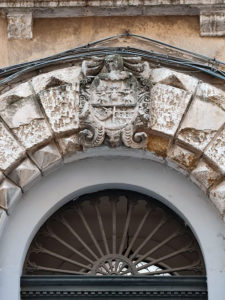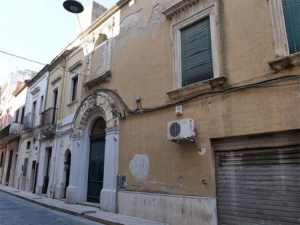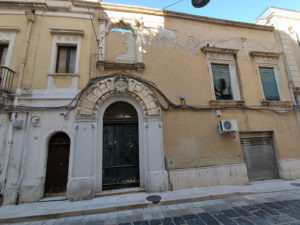Le riunioni segrete della Carboneria
Palazzo Pignaflores (XVI sec.), una delle sedi delle riunioni segrete della Carboneria del Risorgimento brindisino nel XIX sec.
Su via S. Benedetto al civico n.54 sorge il bel palazzo costruito sul finire del’500 ed appartenuto alla famiglia Delle Donne, prima di essere venduto nel 1614 alla famiglia Pignaflores, di cui è lo stemma sul portale, famiglia che si estinse sul finire del XVIII sec. Portato in dote da Elisabetta D’Aprile – pare per regalo del notaio suo padre per le nozze con Oronzo Nisi – il Palazzo è ancora oggi di proprietà Nisi, sebbene una parte sia stata venduta alla famiglia Rodio agli inizi del ‘900. Sullo stemma sono rappresentati due uomini con berrettini che trasportano un pino con fronde legato ad un’asta (chiaro il collegamento al ‘frutto’ del pino, la pigna), oltre a rosette e gigli, mentre dei mascheroni ornano le parti laterali e sottostante e un elmo alato sovrasta il tutto.
Il Vacca ci racconta che il notaio Orazio Nisi (più propriamente Oronzo, come rilevato dalla Cervellera, appurato che in quel periodo a Brindisi non esisteva un notaio Orazio Nisi), sposo della proprietaria Elisabetta D’Aprile, fu un acceso carbonaro, già segnalato come patriota dalla polizia borbonica nel 1821, ed appartenne alla cosiddetta vendita dei decisi, ovvero cerchia ristretta dell’organizzazione clandestina, più radicale ed estremista. Il nome Carboneria deriva dal fatto che i membri dell’organizzazione avevano tratto il loro simbolismo ed i loro rituali dal mestiere dei carbonai, coloro che preparavano il carbone e lo vendevano al minuto, da cui le vendite carbonare.
A Brindisi ci furono diverse vendite carbonare, frequentate segretamente da brindisini di ogni classe sociale; prima del 1820 una di queste, detta Concordia, si riuniva nel convento dei padri carmelitani della chiesa di S. Teresa, oggi sede, nell’omonima piazza, dell’Archivio di Stato. Palazzo Pignaflores, dunque, ha avuto un importante ruolo nel Risorgimento brindisino, in quanto sede clandestina di riunioni degli spiriti liberali e ed anti-reazionari, dove nel 1821 sfilò anche una mascherata politica nell’ultimo giorno di carnevale. Il fatto che il Palazzo, di importanti dimensioni, confinasse sul lato opposto con via Armengol, rendeva la casa dei Nisi particolarmente sicura, perché poteva assicurare una seconda via di fuga. Per la Cervellera, infine, sebbene non sia citata la fonte del racconto, il Palazzo fu sede di un fatto delittuoso dovuto al clima di paura e di sospetto, ai danni del giovane sacrestano Giovannino della vicina chiesa di San Benedetto, il quale una notte, pur non facendo parte dell’Organizzazione, si presentò ad una segreta riunione, desideroso, diceva, di aderirvi, ma da quel giorno di lui non se ne seppe più nulla.
Note Bibliografiche:
– Nicola Vacca, Brindisi ignorata, ed. Vecchi & C., Trani (BA), 1954
– Nadia Cervellera, I Palazzi di Brindisi, Schena ed., Fasano (BR), 1986
The secret meetings of the Carbonari
Pignaflores Palace (XVI century), one of the headquarters of the secret meetings of the Carboneria in Brindisi during the Renaissance, XIX century.
In via S. Benedetto, at number 54, stands the beautiful palace built at the end of the XVI century, belonged to the family Delle Donne before being sold to the family Pignaflores. The coat of arms on the door belongs to this family, which became extinct at the end of the XVIII century. The palace was brought as a dowry by Elisabetta d’Aprile for her marriage to Oronzo Nisi (a gift of her father, notary). Today it still belongs to the Nisi family, albeit a part of it has been sold to the Rodio family at the beginning of the XX century. On the coat of arms are represented two men with caps, transporting a pine with fronds, tied to a rod (it is a clear reference to the fruit of the pine, the pinecone), together with roses and lilies. Moreover, some masks adorn the underside and side parts- Finally, a winged helmet overlooks everything.
Vacca says that the notary Orazio Nisi (more properly Oronzo, as noted by Cervellera, established that in that period in Brindisi there was no notary with the name of Orazio Nisi) who married the owner of the palace, Elisabetta d’Aprile was a passional carbonaro. He had been already signaled as patriot by the bourbon police in 1921 and belonged to the so-called “vendita dei decisi”, an inner circle of the clandestine organization, more radical and extremist. The name Carboneria comes from the charcoal occupation, from where the organization borrowed symbolism and rituals. Charcoal burners prepared the coal and retailed it, and from this activity comes the name of the “charcoal sales”. In Brindisi there were several charcoal sales, secretly attended by people from all social classes. Before 1820 one of them, called “Concordia” gathered in the convent of the Carmelite Fathers of the church of S. Teresa, where today there is the State Archive. So, Pignaflores Palace has played an important role in the Renaissance of Brindisi, as secret headquarter of the meetings of liberal and anti-reactionary thinkers. There, in 1821 a political masquerade paraded in the last day of Carnival. Nisi’s house was particularly safe because the big Palace bordered with via Armengol on the opposite side, therefore guaranteeing an escape route. Finally, according to Cervellera (albeit she does not cite the source of this tale) the Palace was the site of commission of a crime, due to the climate of suspicion and fear. The victim was the sacristan Giovannino, belonging to the near church of San Benedetto. One night he came in for a meeting, even though he was not part of the Organization. He was anxious to join it, but since that day nobody has heard anything about him.
Bibliographic notes:
– Nicola Vacca, Brindisi ignorata, ed. Vecchi & C., Trani (BA), 1954
– Nadia Cervellera, I Palazzi di Brindisi, Schena ed., Fasano (BR), 1986




